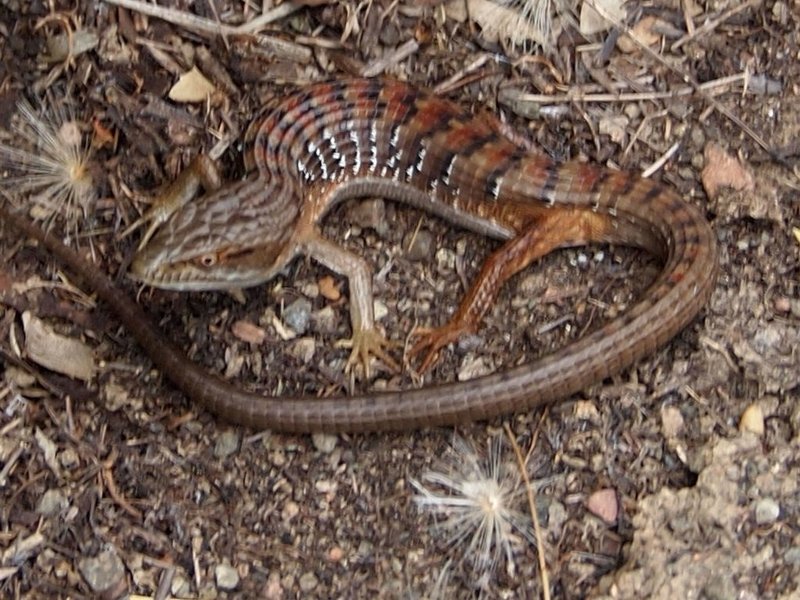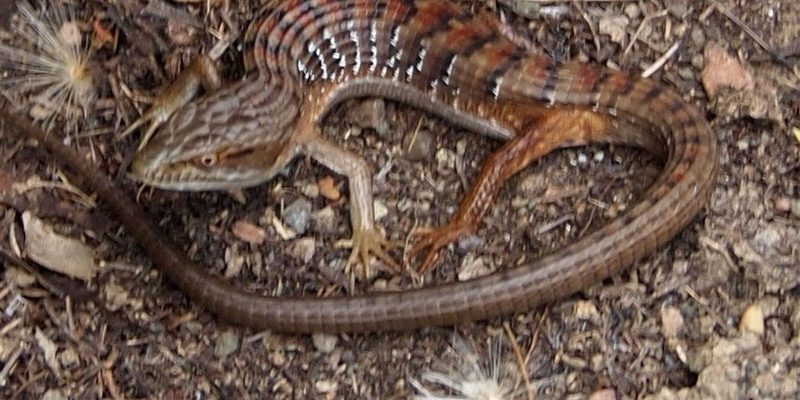
The Northern Alligator Lizard is one of those creatures that can easily spark curiosity. Picture a small, agile reptile that moves with a confidence you might not expect. Native to the western regions of North America, this lizard is known for its unique appearance and fascinating behaviors. With a body that often resembles that of a mini alligator, it’s no surprise where it gets its name.
These lizards have adapted to a range of habitats, from forest edges to rocky hillsides. You might spot one basking in the sun or scurrying through the underbrush. Each encounter leaves you wondering about its life and habits. Let’s unravel the mysteries surrounding this intriguing reptile!
Physical Characteristics
The Northern Alligator Lizard can be easily recognized by its distinct features. Typically, it has a robust body that can measure anywhere from 15 to 25 inches long. Its skin is often a mix of green, brown, and gray hues, which act as perfect camouflage against its natural surroundings. When you see one in the wild, you might first think it’s just another rock or branch until it moves.
Another remarkable aspect about these lizards is their somewhat alligator-like appearance. Their skin is covered with intricate scales that add texture, and their head is a bit broader than that of other lizards. This gives them a fierce look, although they are generally harmless. Their long tail, which can be over half their body length, plays a crucial role in their balance and agility.
One downside, however, is that if they feel threatened, they may drop their tail to escape predators. This process, known as autotomy, helps them evade danger but can be quite stressful. Interestingly, their tail can regenerate over time, although it won’t look exactly like the original.
Habitat and Distribution
Northern Alligator Lizards make their home in a variety of habitats. You can find them in the lush forests of the Pacific Northwest, particularly in areas that provide plenty of cover. These lizards prefer areas with low vegetation, such as shrubs and grasses, where they can hide from predators while also hunting for food.
They are primarily ground-dwellers but can often be seen climbing low bushes or logs. This ability to maneuver through different terrains allows them to thrive in diverse environments, from urban gardens to natural forests. If you live in areas like California, Oregon, or Washington, consider yourself lucky! You might just catch a glimpse of these fascinating reptiles in your backyard.
Keep in mind that seasonal changes impact their habitat choices. During colder months, they tend to seek shelter in burrows or under rocks, while in warmer seasons, they bask in the sun to regulate their body temperature. This fluctuation helps them adapt to the ever-changing climate.
Diet and Feeding Behavior
The diet of the Northern Alligator Lizard primarily consists of insects, making them quite beneficial for gardens and ecosystems. They have a predilection for crickets, grasshoppers, and beetles. Their quick reflexes and excellent vision aid them in catching prey swiftly.
These lizards don’t shy away from munching on smaller lizards, baby birds, or even slugs—whatever they can find to satisfy their hunger. Their feeding strategy often involves sneaking up on their prey and using a quick dart of their tongues to snatch it up. It’s fascinating to watch, as they exhibit a level of agility and speed that’s impressive for their size.
It’s important to note that they are opportunistic feeders. This means that their diet can change based on the availability of food sources. If you have a pet Northern Alligator Lizard, providing a varied diet is essential to keep them healthy. In the wild, they eat what they can catch, so it’s beneficial for owners to mimic this diversity.
Behavior and Social Structure
Northern Alligator Lizards are generally solitary creatures, but they can display social behaviors during the breeding season. Males often engage in displays of dominance that may include pushing or wrestling. This is their way of establishing territory and attracting mates. You might find it entertaining to watch them interact during these times!
These lizards are also known for their keen sense of their environment. They are mostly diurnal, meaning they are active during the day, which gives them ample opportunity to hunt. You’ll often see them basking in the sun to absorb warmth before starting their daily activities.
When it comes to defense, they have a few tricks up their sleeves. As mentioned earlier, they can drop their tails to escape. Additionally, they may hiss or puff up to appear larger and more intimidating, even though they are quite harmless to humans. It’s a clever way to avoid confrontation without resorting to escape.
Reproduction and Lifespan
The mating season for Northern Alligator Lizards usually occurs in the spring, which is a particularly busy time for them. During this period, males become more active and start looking for females. It’s not uncommon to see males engaging in those playful wrestling matches. After mating, the female will lay a clutch of eggs in a moist, sheltered location, like under rocks or decaying leaves.
Depending on environmental conditions, the eggs will incubate for about 45 to 60 days before hatching. Once the baby lizards emerge, they’re on their own from the start. These hatchlings are miniature versions of adults, ready to begin their lives in the wild. The survival rate for young lizards can be quite low due to predators and environmental factors, making their early life a crucial time for them.
Conservation Status
While the Northern Alligator Lizard isn’t currently endangered, habitat loss poses a significant threat to their populations. Urban development and agriculture can lead to a decline in their preferred habitats, making it crucial to protect these areas. Conservation efforts are needed to ensure that their environments remain intact.
Additionally, increasing awareness about these reptiles can help in their conservation. Many people don’t realize the benefits of having these lizards around, like pest control. Educating communities about the importance of preserving their habitats can make a big difference in helping them thrive.
In some locations, there are initiatives to protect their habitats and promote biodiversity. Supporting local conservation programs is a fantastic way to contribute to the survival of the Northern Alligator Lizard and other native species.
Interesting Facts
| Size: | 15 to 25 inches long |
| Habitat: | Forests, rocky hillsides, urban gardens |
| Diet: | Insects, small lizards, slugs |
| Life Span: | 10 to 15 years in captivity |
| Reproduction: | Eggs laid in moist shelter, incubation 45-60 days |
FAQ
Are Northern Alligator Lizards venomous?
No, Northern Alligator Lizards are not venomous. They pose no threat to humans and are generally harmless. However, like any wild animal, they can bite if they feel threatened, but this isn’t common.
What do Northern Alligator Lizards do in winter?
During winter, Northern Alligator Lizards typically go into hibernation. They find refuge in burrows or under leaf litter to escape the cold. This behavior allows them to conserve energy until warmer temperatures return.
How can I attract Northern Alligator Lizards to my yard?
To attract these lizards, create a suitable habitat by placing stones, logs, and dense vegetation in your yard. Providing areas for basking in the sun and shelter from predators will make your yard more appealing to Northern Alligator Lizards.
Can Northern Alligator Lizards change color?
While they don’t change color like chameleons, Northern Alligator Lizards can shift their skin tone slightly based on their environment or mood. This helps them blend in with their surroundings, providing camouflage from predators.
Do Northern Alligator Lizards exhibit parental care?
No, once the eggs hatch, the baby lizards are left to fend for themselves. The mother does not provide care, relying on the instinctual abilities of the young lizards to survive.
What should I do if I find a Northern Alligator Lizard?
If you find one, it’s best to observe it from a distance to avoid stressing it out. If it’s in a dangerous situation, gently guide it back to a safer area using a stick or your hands, being cautious not to touch it directly.
How fast can Northern Alligator Lizards move?
Northern Alligator Lizards are surprisingly quick! They can dart away from predators at impressive speeds, using their agility to navigate through their environment effectively.
Are Northern Alligator Lizards social animals?
They are generally solitary and prefer to spend their time alone. However, during the mating season, you might see them interacting more frequently as males compete for female attention.
What is the best way to care for a Northern Alligator Lizard as a pet?
If you choose to keep one as a pet, ensure you provide a suitable terrarium with appropriate temperatures, hiding spots, and a varied diet. Regular veterinary check-ups and maintaining a clean habitat are also essential for their health.
Is it legal to keep Northern Alligator Lizards as pets?
In many areas, it is legal to keep Northern Alligator Lizards as pets, but it’s vital to check local laws and regulations. Some regions may have restrictions on capturing wild specimens.
Do Northern Alligator Lizards make sounds?
They are relatively quiet but can make hissing sounds if threatened. This vocalization serves as a warning to potential predators, indicating that they feel cornered.
How do I identify a Northern Alligator Lizard?
You can identify a Northern Alligator Lizard by its distinct appearance, which includes a robust body, alligator-like skin texture, and varying colors that help it blend in with its environment. Pay attention to its size and habitat, as these aspects can also provide clues.
What threats do Northern Alligator Lizards face in the wild?
Threats include habitat loss due to urban development, predators like birds and snakes, and pollution. Protecting their natural habitats is crucial for their survival and well-being.

